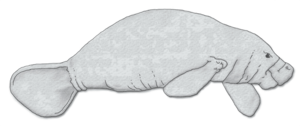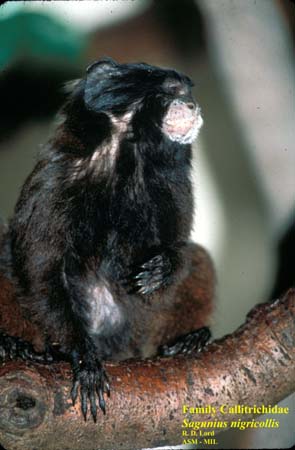List of mammals of Peru facts for kids
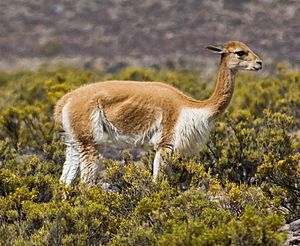
Peru is home to an amazing variety of animals! This article lists the mammal species found in Peru. There are 417 different kinds of mammals living here. Sadly, some of them are in danger. Five species are in critical danger, nine are endangered, thirty-two are vulnerable, and ten are almost threatened.
Scientists use special tags to show how safe or endangered each animal species is. These tags come from the International Union for Conservation of Nature (IUCN):
| EX | Extinct | This means the last animal of its kind has died. It's gone forever. |
| EW | Extinct in the wild | These animals only live in zoos or special protected areas. They no longer exist in their natural homes. |
| CR | Critically endangered | These animals are in extreme danger of disappearing from the wild very soon. |
| EN | Endangered | These animals face a very high risk of disappearing from the wild. |
| VU | Vulnerable | These animals are facing a high risk of disappearing from the wild in the future. |
| NT | Near threatened | These animals are not in immediate danger, but they might be in the future. |
| LC | Least concern | There are no big worries for these animals right now. They are doing okay. |
| DD | Data deficient | We don't have enough information to know how safe these animals are. |
Contents
- Amazing Mammals of Peru
- Manatees: Gentle Giants of the Water
- Armadillos: Little Armored Friends
- Sloths and Anteaters: Slow and Steady, or Long-Tongued!
- Primates: Monkeys of the Peruvian Forests
- Rodents: The Largest Group of Mammals
- Lagomorphs: Rabbits and Hares
- Shrews: Tiny Insect Eaters
- Bats: The Only Flying Mammals
- Whales and Dolphins: Ocean Mammals
- Carnivores: Meat-Eating Mammals
- Odd-Toed Ungulates: Tapirs
- Even-Toed Ungulates: Deer, Peccaries, and Llamas
- Opossums: Marsupials of the Americas
- Shrew Opossums: Tiny Andean Marsupials
- See also
Amazing Mammals of Peru
Manatees: Gentle Giants of the Water
Manatees are large, gentle mammals that live entirely in water. They are plant-eaters and can be found in rivers, estuaries, and coastal areas. All four types of manatees around the world are endangered.
- The Amazonian manatee (Trichechus inunguis) is a vulnerable species found in Peru. It loves to swim in the Amazon River.
Armadillos: Little Armored Friends
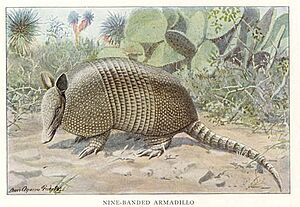
Armadillos are small mammals known for their unique bony shells. They are native to the Americas. There are about 20 different kinds of armadillos alive today.
- The Nine-banded armadillo (Dasypus novemcinctus) is a common sight and is of least concern.
- The Giant armadillo (Priodontes maximus) is a vulnerable species. It is the largest armadillo!
Sloths and Anteaters: Slow and Steady, or Long-Tongued!
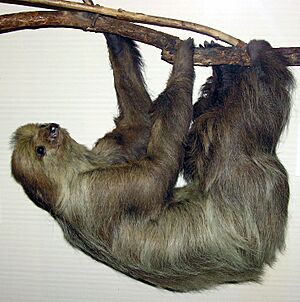
This group of mammals lives only in the Americas. It includes the slow-moving sloths and the fascinating anteaters.
- Sloths:
- The Brown-throated three-toed sloth (Bradypus variegatus) is often seen hanging upside down.
- The Linnaeus's two-toed sloth (Choloepus didactylus) and Hoffmann's two-toed sloth (Choloepus hoffmanni) are also found here.
- Anteaters:
- The tiny Silky anteater (Cyclopes didactylus) is the smallest anteater.
- The huge Giant anteater (Myrmecophaga tridactyla) has a very long tongue to catch ants. It is near threatened.
- The Northern tamandua (Tamandua mexicana) and Southern tamandua (Tamandua tetradactyla) are smaller anteaters that often climb trees.
Primates: Monkeys of the Peruvian Forests

Peru's forests are home to many types of monkeys. These amazing animals are part of the primate family, just like humans!
- Tamarins and Marmosets: These are small, active monkeys.
- The tiny Pygmy marmoset (Cebuella pygmaea) is one of the smallest monkeys in the world.
- Many types of tamarins live in Peru, like the Brown-mantled tamarin (Leontocebus fuscicollis) and the Black-mantled tamarin (Leonotcebus nigricollis).
- The Goeldi's marmoset (Callimico goeldii) is a vulnerable species.
- Capuchin and Squirrel Monkeys:
- The Humboldt's white-fronted capuchin (Cebus albifrons) is a smart and curious monkey.
- The Black-capped squirrel monkey (Saimiri boliviensis) is known for its playful nature.
- Night Monkeys: These monkeys are active after dark.
- The Peruvian night monkey (Aotus miconax) is a vulnerable species.
- Titis, Sakis, and Uakaris:
- The Rio Mayo titi (Callicebus oenanthe) is a vulnerable species.
- The Monk saki (Pithecia monachus) has long, shaggy fur.
- The Bald uakari (Cacajao calvus) is near threatened.
- Howler and Spider Monkeys: These are larger monkeys.
- The Mantled howler (Alouatta palliata) is famous for its incredibly loud calls that can be heard far away.
- The White-fronted spider monkey (Ateles belzebuth) is a vulnerable species.
- Woolly Monkeys:
- The Yellow-tailed woolly monkey (Lagothrix flavicauda) is a critically endangered species, meaning it's in extreme danger of disappearing.
Rodents: The Largest Group of Mammals
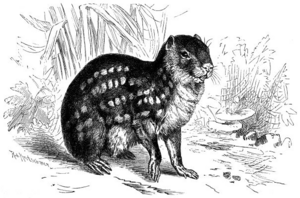
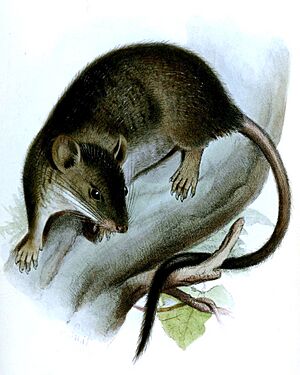
Rodents are the biggest group of mammals, making up over 40% of all mammal species! They have two front teeth that never stop growing, so they have to keep gnawing to keep them short. Most rodents are small, but the capybara can weigh up to 45 kilograms (about 100 pounds)!
- Porcupines:
- The Bicolor-spined porcupine (Coendou bicolor) has spines for protection.
- Chinchillas and Viscachas:
- The Short-tailed chinchilla (Chinchilla chinchilla) is endangered and no longer found in the wild in Peru.
- The Northern viscacha (Lagidium peruanum) lives in the mountains.
- Pacarana:
- The Pacarana (Dinomys branickii) is a unique, vulnerable rodent.
- Guinea Pigs and Capybaras:
- The Guinea pig (Cavia porcellus) is a well-known pet, but wild ones live in Peru.
- The Capybara (Hydrochoerus hydrochaeris) is the largest rodent in the world!
- Agoutis and Pacas:
- The Lowland paca (Cuniculus paca) is a large, spotted rodent.
- The Mountain paca (Cuniculus taczanowskii) is near threatened.
- Tree Rats and Spiny Rats:
- The Bare-tailed armored tree-rat (Pattonomys occasius) is critically endangered.
- Squirrels:
- The Neotropical pygmy squirrel (Sciurillus pusillus) is a tiny squirrel.
- The Sanborn's squirrel (Sciurus sanborni) is near threatened.
- Mice and Rats: Peru has many species of mice and rats, often named after where they live or their discoverers.
- The Peruvian fish-eating rat (Neusticomys peruviensis) is an endangered species.
- The Ucayali spiny mouse (Scolomys ucayalensis) is also endangered.
- The Small hocicudo (Oxymycterus hiska) is a vulnerable species.
Lagomorphs: Rabbits and Hares
Lagomorphs look a bit like rodents, but they are a separate group. They include hares and rabbits. One key difference is that they have four front teeth in their upper jaw, not two.
- The Andean tapetí (Sylvilagus andinus) is a type of rabbit found in the Andes mountains.
- The Common tapetí (Sylvilagus brasiliensis) is an endangered species.
Shrews: Tiny Insect Eaters
Shrews are small, insect-eating mammals that look a bit like mice.
- The Thomas' small-eared shrew (Cryptotis thomasi) is found in Peru.
Bats: The Only Flying Mammals
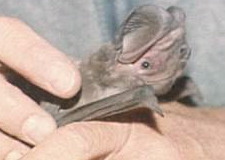
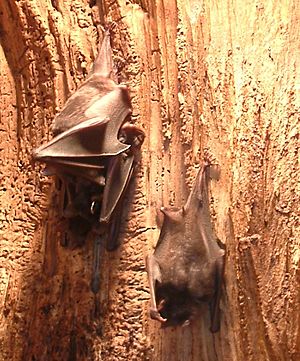
Bats are truly unique because they are the only mammals that can fly! Their front limbs have become wings. About 20% of all mammal species are bats.
- Bulldog Bats:
- The Greater bulldog bat (Noctilio leporinus) is known for catching fish with its feet.
- Brown Bats:
- The Atacama myotis (Myotis atacamensis) and Harmless serotine (Eptesicus innoxius) are vulnerable species.
- Mastiff and Free-tailed Bats:
- The Western mastiff bat (Eumops perotis) is a large bat.
- The Kalinowski's mastiff bat (Mormopterus kalinowskii) is vulnerable.
- The Incan little mastiff bat (Mormopterus phrudus) is endangered.
- Ghost Bats:
- The Greater ghost bat (Diclidurus ingens) is a vulnerable species.
- Big-eared and Round-eared Bats:
- The Behni's big-eared bat (Glyphonycteris behnii) and Carriker's round-eared bat (Lophostoma carrikeri) are vulnerable.
- Nectar Bats: These bats drink nectar from flowers.
- The Handley's nectar bat (Lonchophylla handleyi) and Western nectar bat (Lonchophylla hesperia) are vulnerable.
- The Long-snouted bat (Platalina genovensium) is also vulnerable.
- Fruit-eating Bats:
- The Fraternal fruit-eating bat (Artibeus fraterculus) is a vulnerable species.
- The Lesser yellow-shouldered bat (Sturnira nana) is also vulnerable.
- Vampire Bats:
- The Common vampire bat (Desmodus rotundus) is known for feeding on blood.
- Smokey Bat:
- The Smokey bat (Amorphochilus schnablii) is a vulnerable species.
Whales and Dolphins: Ocean Mammals

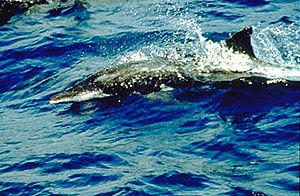


Whales, dolphins, and porpoises are mammals that live entirely in the water. They have sleek bodies and flippers for swimming. Most live in the ocean, but Peru also has freshwater dolphins in the Amazon River.
- Baleen Whales: These whales have baleen plates instead of teeth to filter small creatures from the water.
- The Southern right whale (Eubalaena australis) is a large, slow-moving whale.
- The Sei whale (Balaenoptera borealis), Fin whale (Balaenoptera physalus), and Blue whale (Balaenoptera musculus) are all endangered species. The blue whale is the largest animal on Earth!
- The Humpback whale (Megaptera novaeangliae) is known for its beautiful songs and is vulnerable.
- Toothed Whales and Dolphins: These whales have teeth to catch their prey.
- The Amazon river dolphin (Inia geoffrensis) lives in freshwater rivers.
- The Sperm whale (Physeter macrocephalus) is the largest toothed whale and is vulnerable.
- Many types of dolphins swim in Peru's waters, including the Rough-toothed dolphin (Steno bredanensis), Pantropical spotted dolphin (Stenella attenuata), Spinner dolphin (Stenella longirostris), Common bottlenose dolphin (Tursiops truncatus), and Dusky dolphin (Sagmatias obscurus).
- The Orca (Orcinus orca), also known as the killer whale, is actually the largest dolphin species.
Carnivores: Meat-Eating Mammals

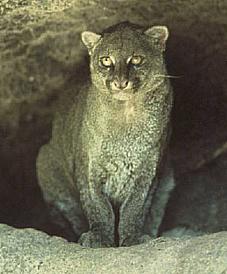


Carnivores are mammals that mostly eat meat. They have special teeth and skulls for hunting.
- Wild Cats: Peru is home to several wild cat species.
- The Andean mountain cat (Leopardus jacobitus) is a rare and beautiful cat living in the Andes.
- The Ocelot (Leopardus pardalis) and Margay (Leopardus wiedii) are spotted cats of the forest.
- The Cougar (Puma concolor) is a powerful hunter found across the Americas.
- The Jaguar (Panthera onca) is the largest cat in the Americas.
- Wild Dogs and Foxes:
- The Culpeo (Lycalopex culpaeus) and South American gray fox (Lycalopex griseus) are types of foxes.
- The Bush dog (Speothos venaticus) is a vulnerable and unusual dog species.
- The Maned wolf (Chrysocyon brachyurus) is a unique, long-legged canid that is near threatened.
- Bears:
- The Spectacled bear (Tremarctos ornatus) is the only bear species native to South America and is vulnerable.
- Raccoons and Relatives:
- The South American coati (Nasua nasua) is known for its long snout.
- The Kinkajou (Potos flavus) is a nocturnal tree-dweller.
- Weasels and Otters:
- The Marine otter (Lontra felina) is an endangered species that lives along the coast.
- The Giant otter (Pteronura brasiliensis) is also endangered and lives in rivers. It's the largest otter in the world!
- The Long-tailed weasel (Neogale frenata) is a quick and agile hunter.
- Seals and Sea Lions:
- The South American fur seal (Arctocephalus australis) and South American sea lion (Otaria flavescens) are found along Peru's coast.
- Skunks:
- The Molina's hog-nosed skunk (Conepatus chinga) is known for its strong scent.
Odd-Toed Ungulates: Tapirs
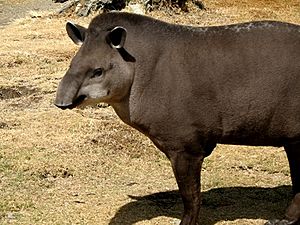
Odd-toed ungulates are large plant-eating mammals. They have an odd number of toes on each foot.
- Tapirs:
- The Mountain tapir (Tapirus pinchaque) is an endangered species living in the Andes.
- The Brazilian tapir (Tapirus terrestris) is a vulnerable species found in the Amazon rainforest.
Even-Toed Ungulates: Deer, Peccaries, and Llamas

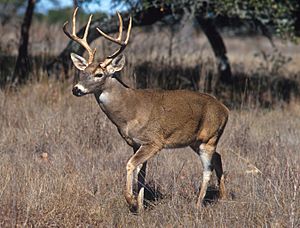
Even-toed ungulates are plant-eating mammals that bear their weight equally on their third and fourth toes. This group includes many animals important to humans.
- Peccaries: These animals look like wild pigs.
- The Collared peccary (Dicotyles tajacu) is a common species.
- The White-lipped peccary (Tayassu pecari) is near threatened.
- Camels and Llamas:
- Deer:
- The Marsh deer (Blastocerus dichotomus) is a vulnerable species and the largest deer in South America.
- The Taruca (Hippocamelus antisensis) is a deer found in the Andes.
- The Red brocket (Mazama americana) and White-tailed deer (Odocoileus virginianus) are also found in Peru.
- The Northern pudu (Pudu mephistophiles) is one of the smallest deer in the world and is near threatened.
Opossums: Marsupials of the Americas
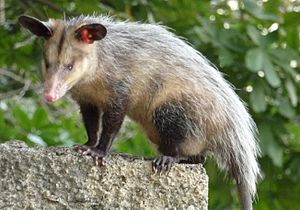
Opossums are marsupials, meaning they often carry their young in a pouch. They are found across the Americas. They are usually small to medium-sized, with a long snout and a tail that can grip things.
- Woolly Opossums:
- The Black-shouldered opossum (Caluromysiops irrupta) and Bushy-tailed opossum (Glironia venusta) are vulnerable species.
- Water Opossum:
- The Water opossum (Chironectes minimus) is a unique opossum that lives in water.
- Common Opossum:
- The Common opossum (Didelphis marsupialis) is a widespread species.
- Gracile and Mouse Opossums: These are small, delicate opossums.
- The Aceramarca gracile opossum (Gracilinanus aceramarcae) and Anderson's mouse opossum (Marmosa andersoni) are critically endangered.
- Short-tailed Opossums:
- The Emilia's short-tailed opossum (Monodelphis emiliae) and Osgood's short-tailed opossum (Monodelphis osgoodi) are vulnerable.
Shrew Opossums: Tiny Andean Marsupials
Shrew opossums are small, shrew-like marsupials that live only in the Andes mountains.
- The Incan caenolestid (Lestoros inca) is one of these rare marsupials.
See also
- List of chordate orders
- List of Peruvian monkey species
- List of prehistoric mammals
- Lists of mammals by region
- Mammal classification
- List of mammals described in the 2000s


